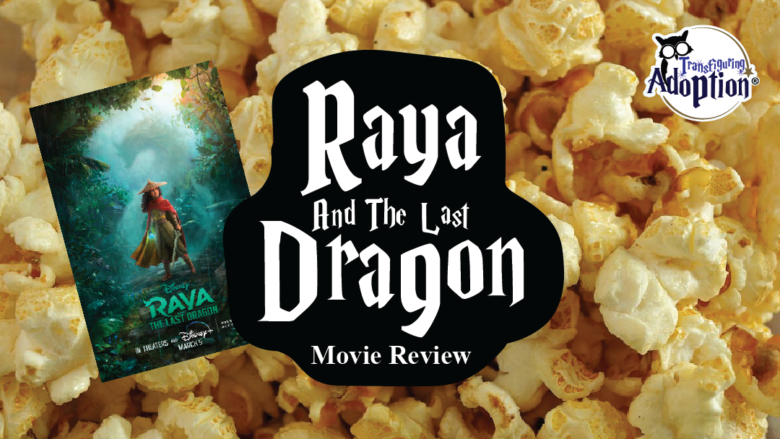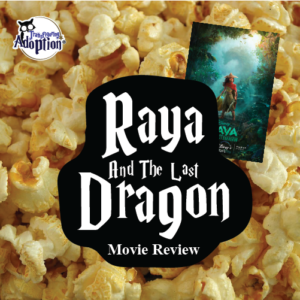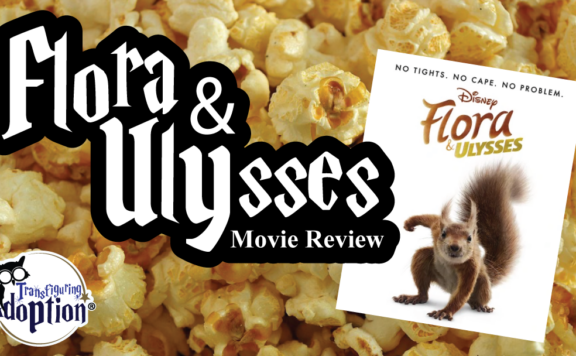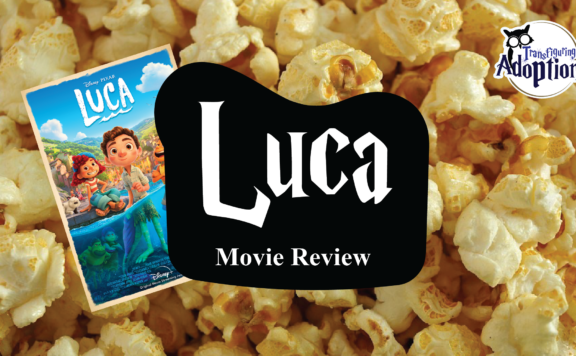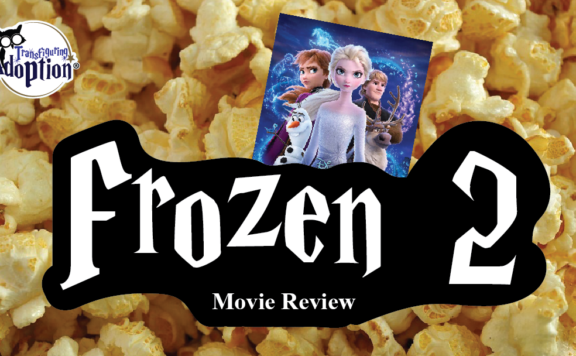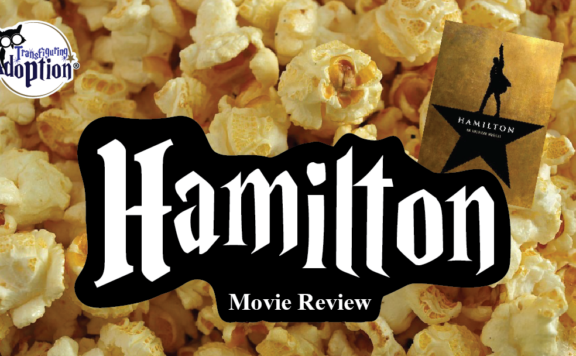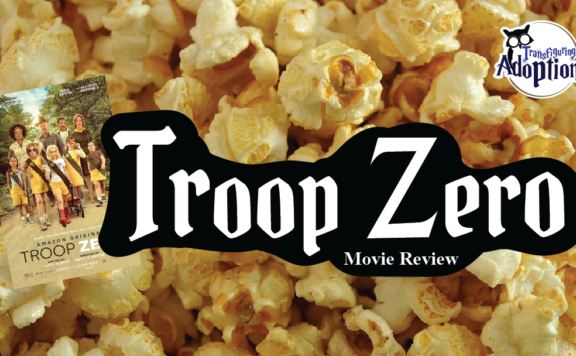Grade:
Transfiguring Adoption awarded this movie 5 Hoots out of 5 based on how useful it will be for a foster/adoptive family. [Learn more about our Hoot grading system here]
Movie Info:
- Rating: PG (Some Violence, Action Thematic Elements)
- Genre: Animation, Adventure, Kids & Family, Fantasy
- Runtime: 108 minutes
- Studio: Walt Disney Animation Studios, Walt Disney Pictures
From the Cover of Raya and the Last Dragon (2021) by Walt Disney Animation Studios and Walt Disney Pictures:
“Long ago, in the fantasy world of Kumandra, humans and dragons lived together in harmony. But when sinister monsters known as the Druun threatened the land, the dragons sacrificed themselves to save humanity. Now, 500 years later, those same monsters have returned and it’s up to a lone warrior, Raya, to track down the last dragon in order to finally stop the Druun for good. However, along her journey, she’ll learn that it’ll take more than dragon magic to save the world–it’s going to take trust as well.”
Transfiguring Adoption’s Overview:
This movie is a fantastic opportunity for families to discuss grief and loss, cultural awareness, and healing from trauma.
The target audience appears to be children that are 8 and up. It also appears this movie would be best for any family that would enjoy a great, action packed movie with lots of heart. Due to events of the film several characters experience significant losses of loved ones that may or may not be permanent.
** Spoilers Could Be Ahead **
How Is This Relevant To Adoption & Foster Care?
Raya and the Last Dragon (2021) is about the fantasy world of Kumandra, which has been divided for hundreds of years following the Druun (the dark-spirited equivalent of Dragons) defiling the land’s resources and turning all Dragons (and many people) into stone. Though Sisu, the last dragon, was able to seal away the Druun and heal all the people inflicted by the Druun’s curse (turning beings into stone), the Dragons were not restored. Raya’s home The nations (Fang, Heart, Spine, Talon, and Tail) are all named for the parts of a Dragon but remain divided following Sisu’s sealing of the Druun. Hundreds of years later, as Chief Benja of Heart (guardian of the Sisu’s orb that sealed Druun and Raya’s father) attempts to make amends with the other nations the but young Namaari of Fang manipulates Raya into revealing the location of the orb and in the attempt to steal the orb breaks the seal and releases Drunn. Chief Benja sacrifices himself to save Raya before succumbing to the Druun’s curse and turning into stone. The film takes place six years later with a very jaded Raya and the various companions she encounters after reviving Sisu to restore the orb’s seal.
While there is no foster care or child welfare in existence in this world, the release of Drunn leaves many families in grief and many children without families, including every companion that joins Raya in restoring Sisu’s orb. Raya must overcome her distrust of others to eventually restore the orb and, ultimately, Jumandra. While our kids aren’t likely in the midst of a great quest like Raya children that have endured trauma and show the emotional scars through survival behaviors, grief, and cross-cultural confusion may very much relate to Raya, Sisu, Namaari in other characters as they tackle the emotional toll this journey involves as they heal their world and themselves. Families can certainly benefit from conversations over this delightful but soulful film but be cautious if their children tend to react strongly to strong, emotionally cathartic movies.
Discussion Points:
- Grief and Loss
Much like several Disney movies of past princesses there is not a happy ending before our heroine and her companions experience grief and loss. Raya’s experience is not exempt from the long-held Disney troupe of an orphaned princess following her father’s sacrifice to save her from the Druun. Over the course of the film we learn that nearly every character has lost someone or many loved ones, including Boun losing his family, Little Noi losing her parents, and Tong losing his entire village. While Namaari does not outright identify a specific loss, it is clear that due to her upbringing she (like Raya) lost their childhood and a connection to their culture in that Dragons are practically extinct until the discovery of Sisu. Much like these characters children that have endured trauma or have come into the child welfare system have many losses to grieve and have seldom been given the time, space, and emotional/cognitive tools and intelligence to honor the grief from various losses, countless moves, and the emotional turmoil inside themselves. Children (regardless of age) need an adult that is bigger, stronger, wiser, and kind enough to help walk them through this grief with the understanding that prolonging grief in a child will only transfer trauma elsewhere. This can be difficult for caregivers as it is hard to watch a child suffer and very tempting to distract the child from pain. Being a trauma informed caregiver means being prepared to walk through grief themselves and help guide their child through grief’s ebb and flow until they reach acceptance as many times as it takes. - Cultural Awareness
Kumandra, while one big fantasy world, certainly has some stark contrasts between Tail, Talon, Spine, Fang, and Heart shown as Raya ventures on and meets her new companions. Due to Namaari’s costly betrayal of Raya and the global fallout after Druun’s unsealing, the once exciting and vibrant cultures Raya wanted to experience and befriend now appear filled with danger at every turn. Raya and each of her companions all clearly have a different perspective of Heart holding the Sisu’s Dragon Gem and who was at fault for the fallout that ensued, and naturally because of the conflicting narratives there are stereotypes that perpetuate throughout the film. Children that have been separated from their home culture may experience similar culture shock to that of Sisu, in finding that not every person is trustworthy, or as Raya in her distrust and distance kept with others. It will be up to the caregiver to help bridge the gap between the child and their culture to allow proper exploration of their identity while judging biases that caregiver and the child alike may hold. This is only possible through frank and honest discussion between child and caregiver once a caregiver has recognized their own biases and been able to work through them as well. Remember, we all have biases but we all also have the ability to identify them and transform with better knowledge and understanding of others. - Healing from Trauma
While this movie is an incredible experience there is an unreal amount of trauma and consequences of trauma shown throughout the film. Raya and each of her companions have learned new ways to navigate the world based on their own experiences and developmental level. This is why Sisu, at hundreds of years old, may appear child-like in her trust for others compared to the jaded young adult Raya, stealthy infant Little Noi, and overly friendly and ambitious Boun at 10 years old. This also explains some of the difficulty warrior-like adult Tong appears to have in expressing his thoughts and feelings too since it’s not clear how old he is or how long he has been in total isolation. The bottom line is that each of these characters have developed mechanisms to help them survive in the dystopian-esque Kumandra but these behaviors are maladaptive in forming relationships with others and many conflicts arise from these conflicting survival behaviors. Children that have endured trauma will also display these behaviors in your home once the honeymoon period is over and the child feels safe enough to trust you, the caregiver, with the real pain they hold inside. Caregivers need to be trauma-informed, understanding that behavior is a form of communication of need and that children that have endured trauma usually lack the ability to link feelings and needs to their own behavior. This means the caregiver will need to use their observation skills to help meet that child’s need, regulate them to a state of calm, and then teach new skills to communicate needs more effectively later. This will also require a lot of work on the caregiver’s part to develop trust as connection is essential for correction of such behaviors due to how deeply ingrained this child’s behaviors are linked to their sense of survival.
Cautionary Points:
- Fantasy Violence
This movie is fairly action-packed and does feature several fight scenes. The fighting is all either hand-to-hand or with weapons such as swords and spears and does not feature overt repercussions to the characters such as debilitating injury or blood. However, if your child is sensitive to action sequences of this nature a caregiver should be aware that these fights are very common throughout the movie.
- Fantasy Stunts & Sequences of Peril
Being a fantasy action movie with Dragons and other mythical elements there are several unrealistic stunts and sequences of peril in which everyone comes out completely unscathed. This includes some jump-scares and traps as well. While this is good in not subjecting children to too much scary or graphic content, the nature of some of these stunts like jumping from tall heights and attacking others could potentially be mimicked by a child that does not understand that these stunts are not realistic (and would injure a human child). Caregivers should be aware if this applies to a child in their home.
- Instances of Deception and Manipulation
Throughout the film several characters struggle with deceiving and manipulating others or the ramifications of such mental tactics. At the start of the film Naamari betrays Raya’s trust by revealing the location of the Dragon Gem (the orb with Sisu’s seal) and this starts the series of events that renders Kumandra into a Druun-infested dystopian hellscape again. It is also revealed that Fang is teaching their youth an alternate history of events to perpetuate a colonialism narrative. Several other characters display survival behaviors (i.e. – lying, stealing, using aggression/defiance to keep others away, manipulating, withdrawing, etc.) to keep themselves safe and this sometimes has maladaptive consequences as well. Children that have been through trauma have not only been subjected to instances of abuse, deception, and manipulation, but have had to use such tactics to survive before they met you and came to your home. Caregivers need to be prepared in the event a child is triggered by seeing the portrayed abusers or victims of trauma act out with these survival behaviors and in turn acts out too. - Strong Emotional Content
Oh the feels. This movie is wonderful in how it explores non-romantic human relationships and overcoming grief and loss but with that comes with some big, cathartic sequencences that may be too deep for some children to handle if some painful grief is actively happening for your child. Sisu’s separation from her siblings, Raya from her father, and several other characters have some intense emotions that perhaps a smaller child may not notice but older children certainly will. These themes can be wonderfully therapeutic if there is a bigger, stronger, wiser, kinder caregiver (you) to discuss them after but being left alone with these emotions may trigger deep emotions in your child and as a result bring about some survival behaviors if left unchecked.
- Themes of Loss and Apparent Death
Most of the characters that succumb to the Druun are turned to stone so it is unclear if they are dead or merely frozen in time and so their losses are grieved as deaths by many main and minor characters. This also includes acts of self-sacrifice and an accidental death at the hands of Raya and Namaari for Sisu. Children that have endured trauma and entered the child welfare system are all too familiar with the emotional limbo that comes with being in care. These themes can be a wonderful discussion point as well, but also could trigger deep feelings of grief in your child if left unchecked as well. It is important for a caregiver to be aware of this so that children do not have to walk through the very important grief process alone.
- Borderline Inappropriate Humor
This is truly a PG movie so there are a few moments of humor thrown in that hopefully will fly over kids’ heads. Little Noi slings a gross diaper in self-defense for some laughs while Tong uses phrases such as “Bad-axery” when referring to his axe-based fighting skills. There are also a plethora of fictional creatures in Kumandra, including the “Toot-Boom”, which is a beetle that farts explosive gases. These references may fly over most kids’ heads, but if a child that has a habit of mimicking inappropriate phrases or actions like this a caregiver may need to be prepared for discussion about the inappropriateness of such humor.
- Incompetant Adult
Well, this one is a “sort of” involving Sisu specifically. While Sisu is technically a younger dragon that has been emotionally frozen for a time she does present as an adult-like character that appears incompentent and in need of supervision by children. Technically Raya is likely a younger adult but her younger companions (10 year-old Boun and infant Little Noi) often have to step in or supervise Sisu to keep her naivety from being her end.
Discussion Guide:
- Why are Raya, Boun, Little Noi, and Tong alone? What happened to their families and villages?
Caregiver Note: This is an introductory question to help start the discussion with your child about the subject of grief and loss. Children develop within the contexts of relationships as humans are social beings. If children do not have secure attachments with bigger, stronger, kinder, wise caregivers they may miss out on emotional and cognitive growth opportunities, which may contribute to your child’s struggles to connect feelings to behaviors. Your child may recognize that each of these characters have lost parents, siblings, and neighbors, but they may not connect that they each react to these losses and express grief differently. - How do Raya, Boun, Little Noi, and Tong act differently after they have lost their loved ones? How are they acting alike?
Caregiver Note: This is a question that will continue to ease the conversation into talking about themselves. It’s much easier to see someone else’s struggles more so than our own and children are no different. Help your child connect how Raya keeps others at an emotional distance and struggles to express how she feels, how Boun has become self-sufficient and stays busy to not think about loss, how Little Noi has found a new “family” in her animal companions, and Tong remains isolated in his grief. Your child may also pick up on other patterns that you didn’t notice, and if that is the case that is great! Your child is building social and emotional intelligence! - How have you felt before when you were far away from someone you loved? What helps when you miss them the most?
Caregiver Note: This question brings the subject to your child’s sense of grief and loss. Now that we have connected with the characters’ emotions we can start to connect your child to their own feelings of grief and loss after the practice with Raya and her companions. Depending on the depth of your relationship and your child’s comfort level this question may be difficult for them to talk about. If your child resists talking about this too much, it’s best to not force it and allow them to talk as in depth as they wish. Coming up with a plan together for how they can be comforted when they are so sad or angry that words (which are processed in the prefrontal cortex, the same area of the brain where emotional regulation is housed and is often underdeveloped in children with trauma) are hard you can work together as a team with the grief instead of having caregiver squared off against the child and their behaviors. - ACTIVITY: Kumandra Dragon Puzzle
Caregiver Note: Chief Benja says in the start of the film that he believes that Tail, Talon, Spine, Fang, and Heart can be Kumandra again but that someone has to take the first step. So while you and your child discuss the movie, let’s take that step!
For this activity you will need a rectangular piece of cardboard that will be big enough to hold your puzzle’s picture but easy to cut, scissors, a black marker, and colored markers to draw all sorts of landmarks. The adult may need to help the child depending on their age.
Help your child draw the figure of a dragon centered on the cardboard. They will need to spread out areas that will represent the Tail, Talons (maybe of one particular foot), Spine, Fang, and Heart. Decorate your regions with all the different plant and geographic features your child wishes that you may then color in. Then, take your black marker and decorate a map border for the edges and boundaries for the different areas. Cut the area boundary lines and you and your child will have your very own Kumandra map puzzle!
For an extra step you can put clear packing tape over the parts before coloring the details and use dry erase markers to give Kumandra all sorts of looks and color combinations several times! - Why do Raya and Tong have so much misinformation about the other villages’ cultures and habits?
Caregiver Note: It is very clear that even before Namaari’s betrayal of Raya that each of the villages of Kumandra have strong, often negative stereotypes that are heavily held after the Druun breaks out of Sisu’s seal. I can relate to this very much as someone that grew up in two areas of the United States of America that often get some heavily hurtful stereotypes: the South and Appalachia. Usually when those terms are heard visions of hillbillies, Scarlett O’Hara, and other troupes come up fairly quickly. These stereotypes are so pervasive that many of my peers (including myself) were pressured to “drop” our accents in favor of a more neutral accent to improve our ability to get jobs and better education opportunities. This is because the accents of these regions are stereotypically that of someone “ignorant” or “uneducated”. In reality, our language use and accents in these areas are quite diverse and the people that speak these dialects are far from unintelligent. There are many areas in which stereotypes can breed harmful biases between people groups whether they be regional (like in Raya and the Last Dragon (2021) ), racial, gender-based, or of any other cultural component. It is important that we learn to identify our biases and learn from them rather than pretend they don’t exist entirely as this can influence our ability to coexist with others.
Your child may notice that other villagers talked about these stereotypes, leaders acted upon these stereotypes, and that different regions taught historical events with different biases and narratives to defend actions. - What helped Raya, Tong, and the others learn to get along with one another? What helped them learn to get along with Namaari and the other residents of Fang?
Caregiver Note: The longer Raya and the others spent time together, the more they each realized that what they had heard was not always true. Raya and her companions slowly learned that a stereotype can be a harmful generalization to apply to a future friend and comrade. After breaking down barriers amongst one another, and learning a lesson in trust from Sisu, Raya was able to make the “first step” in helping mend the relationship the other regions had with Fang, which ultimately saved the world and even brought back the Dragons! The impossible can happen when we learn to truly see our neighbors as future friends and allies rather than waiting for the next enemy to appear. - Why does Raya always distrust everyone so much? Have you ever felt like Raya where it feels like you can’t trust anyone?
Caregiver Note: The next few questions will help your child connect their emotions to survival behaviors using Raya and Sisu as case studies or examples. Children that have endured trauma will often develop safety mechanisms such as survival behaviors to keep themselves safe in the absence of a bigger, stronger, wiser caregiver. With that in mind, after Raya loses her father because of Namaari’s betrayal it makes sense that Raya doesn’t trust others easily. However, outside of Raya’s conflict with Namaari and Fang this has the consequence of emotional distance from everyone and being unable to trust others, like well-meaning Sisu, to carry out important tasks. Help your child connect this concept before moving on to Sisu. - Why does Sisu trust and believe everyone without a second thought? Why does Sisu trust others more than Raya?
Caregiver Note: While we meet Raya as a child and then as a young adult consumed by grief and trauma, Sisu appears to have had a very close, loving relationship with her siblings and to have much more in terms of age and experience when they sacrificed themselves for Sisu to seal Druun. Then, Sisu slept for a couple of hundred years. Sisu reacts very differently due to her experiences of being able to trust her Dragon companions for a long time and this translates to how she so easily trusts others in comparison to Raya. Now, Sisu’s trust for others isn’t perfect in that she is tricked easily by others but Sisu is also open to new relationships with no expectations. It’s important for a caregiver to
remember that though two children may go through similar traumatic experiences (i.e. – losing family members) each child comes with different experiences, developmental ages, and levels of resilience in the face of trauma. As a result, you can see large differences in trauma reactivity in even sibling groups! For this reason a caregiver should be prepared to adjust their parenting and word-choices to help meet children where they are at, much like how Sisu continued to meet her companions where they were in terms of trust whether it was easy as with Namaari or difficult as with Raya. - Are there times where it’s harder for you to trust others like Raya? Are there times where you trust too easily like Sisu? How can I help you find a good balance with trusting others?
Caregiver Note: Here is where you and your child can work together as a team to tackle communication about struggles before they arise. This can be a time to discuss how to identify safe adults vs. unsafe adults or decide if a peer is a good friend vs. best friend. Allow your child to lead the level of depth in this conversation though and be prepared to listen more. Using their words to describe what they think and feel with a safe adult will help those brains develop and learn the valuable life skill of identifying friends. - ACTIVITY: Kumandra Soup by Malika Lim Eubank
Caregiver Note: I don’t know about you, but when I watched this movie I really wanted to try to figure out this soup. I wasn’t very familiar with some of the ingredients mentioned in the movie (like shrimp paste from Tail or palm sugar from Heart) so I naturally looked up a few suggestion recipes and loved how fun Malika makes this yummy experience. One idea for this experience is to work with your children through the preparation work and cooking of this dish while discussing the movie. You can also talk while giving this a try. Of course, you can make substitutions as needed but these are the main ingredients from the movie: shrimp paste from Tail, lemongrass from Talon, bamboo shoots from Spine, chilis from Fang, and palm sugar from Heart. Don’t be too intimidated by the chilis, several chili varieties are more flavorful than “hot” so that’s an easy ingredient to substitute based on your preferences if Thai chilis are too much.
Below is the written recipe as well as a YouTube tutorial with Malika Lim Eubank.
KUMANDRA SOUP – Malika Lim Eubank – https://www.youtube.com/watch?v=73gNDqgQpJU
In honor of the release of Disney’s Raya and the Last Dragon, Malika shows you how to recreate the soup featured in the movie. It’s a perfect meal for the whole family while you enjoy the film on Disney Plus.
INGREDIENTS
- 6 Cups: Chicken Broth
- 1 lb. Uncooked shrimp (use peeled and deveined shrimp if you are in a hurry or use 20 head on jumbo shrimp for extra flavor)
- 1 package of mild mushrooms (I used 3.5 oz package of Beech Mushrooms)
- 1-2 limes
- 1/4 cup fish sauce
- 1 bunch cilantro
- 1 in piece of galanga (aka Siamese Ginger)
- 1/2 c coconut cream (optional)
- 1 tablespoon shrimp paste
- 2 large stalks lemongrass
- 1 c bamboo shoots
- 5 Thai chilis sliced on the bias
- 1 tsp palm sugar
INSTRUCTIONS
- Heat chicken broth to a boil over high heat.
- SKIP this step if using head-on shrimp. Otherwise, remove shrimp heads, peel and devein adding the heads and shells to the broth as it comes to a boil. Once all the heads are all in the pot, use the back of a spoon or spatula to press the heads against the pot to encourage the release of all that wonderful flavor.
- Now bruise the 2 lemongrass stalks and cut them in half. Cut the bottom half (white portion) into large 3 in long pieces and add to the broth.
- Slice the galanga root into thin slices approx 1/8 in and add to the broth.
- Break off the stems of the cilantro and add the stems to the broth.
- Prepare the rest of the ingredients. Clean and separate the mushrooms. Slice bamboo shoots into rounds about 1/8 in thick. Slice the chilis on the bias, slice the remaining lemongrass pieces, slice lime for squeezing, crush palm sugar, remove about 2tbsp of leaves from cilantro.
- Use a slotted spoon or skimmer to remove the lemongrass, galanga, cilantro stems and shrimp heads and shells from the broth.
- Add the mushrooms and shrimps to the broth and cook till almost done (about 7 minutes for jumbo shrimp).
- Add half of the cilantro leaves (about 1 tbsp).
- Now is the time to recreate the scene from Raya! Add shrimp paste, lemongrass, sliced bamboo shoots, sliced chilis and palm sugar.
- Finish the soup with lime juice and fish sauce to taste. I used about 1/4 cup fish sauce and juice from 1 lime.
- Garnish bowl with additional sliced chilis, the rest of cilantro leaves and a dollop of coconut cream. Serve with jasmine rice.
NOTE: Inclusion on these lists does not necessarily mean endorsement. Furthermore, with all our resources, we highly recommend you preview them first to determine if there are any trauma triggers that your child may not be ready to handle. Transfiguring Adoption does not intend for its reviewers nor its reviews to be professional, medical or legal advice. These reviews and discussion guides are intended to help parents to better be able to connect and understand their children who come from traumatic backgrounds.
